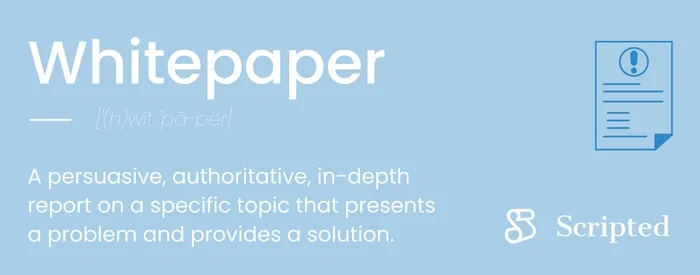- Blog Home
- Emily Chang
- How To Measure Your White Paper's Success
How to Measure Your White Paper's Success

In today's marketing world, you're missing out on invaluable data if you're not tracking your campaigns — and the success of a whitepaper is no different. By focusing on key metrics while leveraging automation tools, you can maximize the ROI of your next intent-driven campaign.
This guide will cover everything you need to know about when to use a white paper, its benefits, and, most importantly, how to measure its effectiveness as part of a broader content marketing strategy. Let's dive in!
What Is a White Paper?
Unlike a casual blog or social post, a white paper is an informational document focusing on a topic and its issues, followed by a potential solution. This content is backed by factual information and data showcasing a company's authoritative, professional voice.
Ultimately, the goal is to create a paper that conveys the benefits of a product, strategy, or service, weaving in answers and solutions related to the company's offerings. For example, you may create an in-depth white paper on the latest trends in marketing automation and the challenges that exist alongside those trends. Based on the value of this material, you could offer it as a downloadable resource in exchange for the reader's email to build your subscription list.
Related: Top Five Tips to Grow Your Email Subscription List
The benefits of creating white papers include the following:
- This invaluable type of content can help you generate solid leads.
- White papers build thought leadership and help you develop an authoritative brand.
- White papers are an effective way to build a mailing list when offered as gated content.
- If you have conducted original research, white papers provide opportunities to present your findings in a meaningful, persuasive way.
Should You Write a White Paper?
There are no black-and-white rules concerning who should and should not publish a white paper. Marketers across all industries use this form of content. However, since white papers are relatively research-intensive and contain factual qualitative data, they can be a better fit for some brands — or at least topics — than others. In many cases, white papers are used by B2B companies to generate leads.
While this is by no means a definitive list, here are some examples of industries and sectors that could benefit from a detailed white paper:
- Insurances
- Transportation
- Healthcare
- Financial services
- Retail
- Non-profits
- Technology
- Manufacturing
- Design
- Food services
When developing topics, components of a good white paper can include:
- The latest industry trends and related problem statement
- Brand-specific solutions
- Product or service guides
- Interesting data insights
- Educational walk-throughs
- Business challenges (either niche or common problems, depending on your audience)
Why Measure a White Paper's Success, and How?
Once you publish your winning white paper, that's just the beginning. To maximize your investment, you must follow up, analyzing relevant data. This step will help ensure a greater ROI based on your ability to utilize valuable insights. The more data you analyze, the more you'll understand about your investment — and how that white paper impacted your overall marketing budget. This information can help you make data-driven decisions to optimize the white paper you're tracking and future papers you publish.
Start exploring key metrics to understand how your white paper is performing.
For example:
- How many times has your white paper been downloaded?
- How much revenue has it generated?
- How many social shares has it received?
- What is its current SEO rank?
Knowing what you want to measure is the first step. For example, tracking white paper downloads is a must if you're most concerned with ROI. However, this is only the first step. To nurture leads, you will likely need to lean on other forms of marketing and the data you collect from those channels.
While there are several tactics, one step you won't want to skip is creating a landing page for your white paper. This approach is crucial when aiming to collect data. If you take this route, utilize tools like Google Analytics to obtain the Landing page report. With this report, you'll gain access to valuable metrics, including:
- Average engagement time per session
- Active users
- Conversions
- New users
- Sessions
- Total revenue
Follow-Up With Email and Social Media
If you created a landing page for your white paper and viewers filled out a form, congratulations, you've converted those visitors into leads. While exciting, this is only the beginning of the buyer's journey. To gain a complete overview of your latest campaign and the buyer's journey, you may want to leverage data from a follow-up email marketing campaign to track your leads. For example, subscribers may receive an email that includes a call-to-action (CTA) after downloading your white paper. You can track conversion rates based on how many recipients purchased your product or service. This tactic is ideal if you're most interested in revenue.
Another option is to share your white paper on social media. Simply share the link to your white paper and track the post's reach. If you want to increase the number of eyes on that specific post, feature it at the top of your Facebook, Twitter, or LinkedIn page. With social media platforms, there are many metrics to consider. However, some of the most important ones for this purpose include:
- Reach
- Impressions
- Engagement rate
- Click-through rate (CTR)
- Conversion rate
If your goal is to draw attention to your white paper via social media and track metrics that way, you must prioritize the quality of your social content.
What About SEO?
If you have been working on a comprehensive content marketing strategy, you know the benefits of SEO. Many marketers are incorporating SEO tactics into their content creation plans, especially concerning blog posts — if you're one of them, great! You can transfer your knowledge of SEO to optimize your white papers.
As discussed, landing pages are often an integral part of tracking the success of white papers, which overlaps with SEO optimization. For example, you can create landing pages for specific buying personas with different keywords to match those consumers. When aiming to track the success of your efforts, focus on ranking. This SEO metric is beneficial but becomes most valuable when prioritizing the bigger picture. For example, if you are ranking, but your white paper isn't receiving any traffic, there's a problem.
Again, leverage the wealth of knowledge available to you. For example, you can view traffic to your white paper's landing page based on channel or total sessions/users/page views over a specified date range. Use this information to make more informed decisions, and if something isn't working, pivot.
Recommended Tools to Measure White Paper Downloads
If you want to start with the basics and tracking downloads, there are several tools to support your efforts. Explore the following options based on what makes sense for your brand.
- Marketo — This automation software "makes the complex buyer journey simple." With a Marketo Measure Persons and Buyer Touchpoints (CRM) report, you can see how many people downloaded your white paper. You can customize the date range based on specific, time-related goals.
- Eloqua (Oracle) — When the goal is to nurture leads while accessing real-time data, Eloqua can be an optimal choice. What's neat about this automated marketing tool is that downloads can trigger a related action. For example, if someone downloads your white paper (trigger), the system may send them a related solution ebook or an invitation for a webinar based on what the white paper highlighted. The detailed reports and dashboard allow you to access a range of measurements, ranging from page views and form submissions to response rates and account engagement.
- Pardot (Salesforce) — This platform offers targeted email campaigns and lead management, focusing on prospective customers that are most likely to convert. This software works by leveraging the data you submit from your Salesforce CRM (or other platforms) and data related to what your prospect does. In this case, how they interact with your white paper, website, social media presence, or offline interactions. This is an excellent tool for easily calculating marketing ROI and gaining a holistic view of each customer.
Scripted Can Help
Without quality white papers, there won't be anything to measure. If your brand would benefit from an in-depth white paper, Scripted's team of talented, industry-specific writers can help you complete the first and most imperative step. You can also gain access to Scripted's Performance & Optimization team to help you monitor content, including your white papers.
Investing in a professional content team can make all the difference in optimizing your ROI while building authority and brand awareness. Whether in the technology, healthcare, energy, retail, or real estate industry, highly-vetted writers are waiting to assist you — many of whom specialize in white paper writing. Having this expertise, knowledge, and passion behind your next white paper is invaluable. After all, without a well-written, well-structured white paper, there won't be much to measure.
Ready to get started with industry experts and all-in-one solutions? Sign up for your 30-day free trial today!



